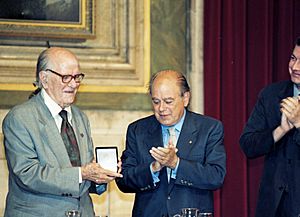Xavier Montsalvatge facts for kids
Quick facts for kids
Xavier Montsalvatge
|
|
|---|---|

Xavier Montsalvatge in 1999
|
|
| Born | 11 March 1912 Girona, Catalonia, Spain
|
| Died | 7 May 2002 (aged 90) Barcelona, Catalonia
|
| Resting place | Cementiri de Sant Gervasi, Barcelona, Spain |
| Nationality | Spanish |
| Education | Conservatori Municipal de Música de Barcelona |
| Occupation | Composer, music critic, music professor |
| Known for | Cinco canciones negras |
| Title | Creu de Sant Jordi (1983), Spanish "Premio Nacional de Música" (1985), Catalan "Premi Nacional de Música" (1997), Medalla d'Or de la Generalitat de Catalunya (1999); Doctor Honoris Causa, Universitat Autònoma de Barcelona; Chevalier de l'Ordre des Arts et Lettres. |
| Spouse(s) |
Elena Pérez de Olaguer
(m. 1947) |
| Children | Xavier, Yvette |
Xavier Montsalvatge i Bassols (born March 11, 1912 – died May 7, 2002) was a Spanish composer and music critic. He was one of the most important people in Catalan music during the second half of the 1900s.
Contents
About Xavier Montsalvatge
His Life Story
Xavier Montsalvatge was born in Girona, Spain. He learned to play the violin and studied how to write music at the Barcelona Conservatory. His main teachers were Lluís Maria Millet, Enric Morera, Jaume Pahissa, and Eduard Toldrà.
After the Spanish Civil War, Montsalvatge started working as a music critic in 1942. This meant he wrote articles about music for a weekly magazine called Destino. He later became the director of this magazine in 1968 and 1975. He also wrote for the newspaper La Vanguardia starting in 1962.
Montsalvatge also went back to teach at the school where he had studied. He became a lecturer, which is a type of teacher, in 1970. Then, in 1978, he became a professor of composition. In 1982, he was a judge for the Paloma O'Shea Santander International Piano Competition.
He won a big award in Spain called the Premio Nacional de Música for his compositions in 1985. Xavier Montsalvatge passed away in Barcelona when he was 90 years old. He was buried in the Sant Gervasi Cemetery in Barcelona.
His Musical Style
Xavier Montsalvatge's music style changed a lot over his career. At first, he was influenced by certain ways of composing, like the twelve-tone technique. His early work, like his Sinfonía mediterránea from 1949, showed this.
Later, he found inspiration in the music from the Antilles, which are islands in the Caribbean. You can hear this in his famous work Cinco canciones negras (Five Black Songs) from 1945. He also wrote Cuarteto indiano (Indian Quartet) in 1952.
He became friends with French composers like Olivier Messiaen and Georges Auric. This led to a big change in his music. His style became more free, using many different musical keys at once. His piece Partida (1958) shows this new style. In the last part of his life, his music showed influences from very modern and experimental styles.
Montsalvatge wrote almost every kind of music. He composed operas, which are plays set to music, like El gato con botas (Puss in Boots). He also wrote chamber music, which is for a small group of instruments, such as Cuarteto indiano. He created many pieces for a full orchestra, like Desintegración morfológica de la Chacona de Bach and Laberinto o Sinfonía de réquiem. His Sinfonía mediterránea also won awards.
He became famous around the world mainly because of his lovely work, Cinco canciones negras. This piece is for a singer called a mezzo-soprano and an orchestra. It mixes Caribbean rhythms and musical ideas. The most well-known song from this collection is Canción de cuna para dormir un negrito (Lullaby to sleep a black child).
Xavier Montsalvatge also wrote music for movies. In 1987, his music for the film Dragon Rapide was nominated for the best original music at the Goya Awards, which are like the Oscars in Spain.
Important Musical Works
Here are some of Xavier Montsalvatge's important musical pieces:
- Cinco canciones negras (Five Black Songs) (1945)
- Concerto breve (Short Concerto) (1953) for piano and orchestra
- Canciones Para Niños (Songs for Children) (1953)
- Sonatine pour Ivette (Sonatina for Ivette) (1962)
- Babel (1967)
- Homenaje a Manolo Hugué (Tribute to Manolo Hugué) (1971)
- Serenata a Lydia de Cadaqués (Serenade to Lydia from Cadaqués) (1971)
- Reflexions-obertura (Reflections-Overture) (1975)
- Concert capriccio (1975) for harp and orchestra
- Fantasía (Fantasy) (1985) for harp and guitar
- Simfonia de Rèquiem (Requiem Symphony) (1985)
- Bric à brac (1993)
- Partita 1958 (1958)
- Euro fanfàrria
Choral Music
- Tres canciones negras (Three Black Songs) (1946) for soprano singer, mixed choir, and piano
Operas
- El gato con botas (Puss in Boots)
- Una voce in off (A Voice Offstage)
- Babel 46 (first performed in 2002)
Ballets
- Perlimplinada, music written with Federico Mompou
- Manfred (1945)
Music for Cobla Ensemble
- Elegia a Juli Garreta (Elegy for Juli Garreta) (1946)
- Madrigal en forma de sardana (Madrigal in the form of a Sardana) (1945)
See also
 In Spanish: Xavier Montsalvatge para niños
In Spanish: Xavier Montsalvatge para niños

